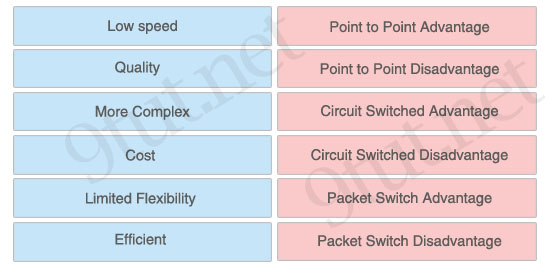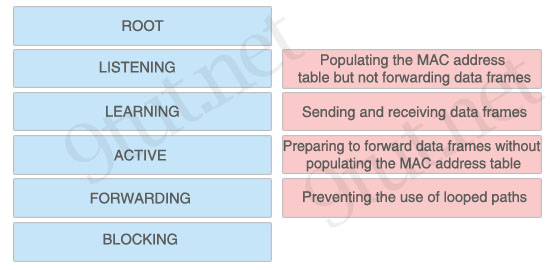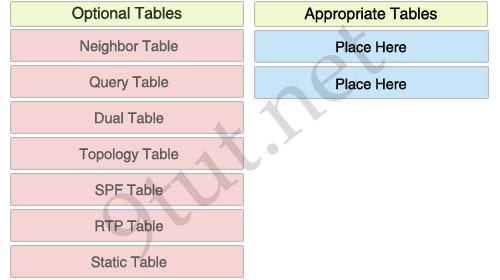ICND2 – Drag and Drop 3
[am4show have=’p2;’]
Premium Member: You can test your knowledge with these questions first via this link.
[/am4show]
Here you will find answers to Drag and Drop Questions – Part 3
Question 1
[am4show have=’p2;’]Drag item on left to match item on right

Answer:
[/am4show]+ Point to Point Advantage: Quality
+ Point to Point Disadvantage: Limited Flexibility
+ Circuit Switched Advantage: Cost
+ Circuit Switched Disadvantage: Low speed
+ Packet Switch Advantage: Efficient
+ Packet Switch Disadvantage: More Complex
Question 2
[am4show have=’p2;’]Place the Spanning-Tree Protocol port state on its functions (not all options on the left are used)

Answer:
[/am4show]+ Populating the MAC address table but not forwarding data frames: LEARNING
+ Sending and receiving data frames: FORWARDING
+ Preparing to forward data frames without populating the MAC address table: LISTENING
+ Preventing the use of looped paths: BLOCKING
Question 3
[am4show have=’p2;’]As a CCNA candidate, you need to know EIGRP very well.
Which tables of EIGRP route information are held in RAM and maintained through the use of hello and update packets?
Please choose two appropriate tables and drag the items to the proper locations.

Answer:
[/am4show]Neighbor Table
Topology Table


Question 2
Preparing to forward data frames without populating the MAC address table: LISTENING
what is being forward in Listening state ?
thanks
To all those who have already made the ICND2
Drag and Drop 3
It still valid?
Amir Reza// Only STP data is being forwarded to share port status and to determine port role in the network
None were there
Passed today my ICND@2 by 1000. Got different configuration of the Eigrp & frame Relay labs where there were different DLCIs and IP addresses, but same process was used to get answers (show commands, show ip protocols, show ip interface brief ).
A question about GLBP and a question about netflow were on my test. You can find them here: http://www.examtut.com/2013/09/new-questions-in-ccna-200-120-hsrp-vrrp.html
Study 9tut and this guy i found him really helpful. He has unique way of teaching http://www.danscourses.com If you can do all his videos again and again. Trust me you will get the concept. Also one thing i learned today is if you don’t know the concept it’ll be hard for you in the exam.
All the best to every one in their path. Keep me in your good wishes.
Sitting in car studying 9tut for last time. Take test in 30 min. Keep me in your well wishes.
I praise Allah pass or fail. And thanks to 9tut.
how did it go shamir? hope you pass
I agree with Amir. can someone please answer this:
Question 2
Preparing to forward data frames without populating the MAC address table: LISTENING
what is being forward in Listening state ?
thanks
Took the exam today. Pass 986/1000. nothing of this question on there.
Thanks 9tut.
Tested today, 8/20. None of these were on there.
@ Q2 questions
The answer states its “Preparing to forward data frames” it doesnt say its actually forwarding anything in the Listen state. The listen state is the state it goes to when the switch stops blocking and is “preparing” to go into forwarding state.
Thanks 9tut!…..i passed today with full score, questions are from debra and wayne dumps and questions found in this page…nothing else is asked!… wish all the best for ppl who are going to take exam….
@ Nir – How to get those dumps?
what does ppp advantage quality mean?
@Amir Reza its BPDUs
Can we get more questions?
Hi 9tut, I found these two issues regarding Q1:
The first issue is this: According to one of the official Cisco Networking Academy books that prepares you for ICND2, “cost” is not an advantage of circuit-switched networks, but a disadvantage. The book reads “Because the subscriber has sole use of the fixed capacity allocation, switched circuits are generally an EXPENSIVE way to move data”. Also, the book states that “because the internal links between the switches are shared between many users, the cost of packet switching is LOWER than that of circuit-switching”.
The second issue is that low speed is not a disadvantage of circuit-switched networks, but a disadvantage of packet-switched networks. Again, the same Cisco book reads “delays are greater in packet-switched networks THAN in circuit-switched networks”.
Circuit-switched networks are faster because there is one dedicated circuit for each user whereas in packet switched networks many users share the internal links. This question does not seem to have the correct advantage & disadvantage matches for the circuit-switch option.
Thanks 9tut, I couldn’t thank you enough for this website!
@jc. I think you are right
Good catch JC. I will research this as well.
Anyone seen these on their exam? Q1 answers look wrong as JC pointed out.
@all: We had to move all the questions and answers out of 9tut. We can only keep the explanation. You can download the questions and answers at: https://mega.co.nz/#!oIdESYbD!yyu33vygrfKPy4rcmcbV6qW2fxINNoTokuDM3CjA_og
@9tut – no display for https://mega.co.nz/#!oIdESYbD!yyu33vygrfKPy4rcmcbV6qW2fxINNoTokuDM3CjA_og
@jayr: You can use this link instead: http://www.4shared.com/office/WXdZDq7Xce/ICND1_2_Questions_July_2015.html
@JC ,
Did you find out which answers are correct?
An example of circuit-switched is dial-up; not only is it slow because of bandwidth speed, but a dedicated connection must first be dialed in to established the connection before it will work. About the only reason anyone would want to use dial-up is low cost or else they can’t get anything else.
thx 9tut
Friends , A Doubt regarding Question 1 As per the question 1 said the Advantage of Point to Point is good quality of Data transfer but disadvantage said to be Limited Flexibitly , but friends the correct answer for disadvantage of ‘ COST’ . Now a days Leased Line OFC is to used connect between 2 branches , the data transfer of Leased Line is good , but amount to be high .
Become a member to get the next generation Network Emulator
http://dvensys.com
New RELEASE Dumps Exam questions updated. , get download at below page:
http://rebrand.ly/newic2b92